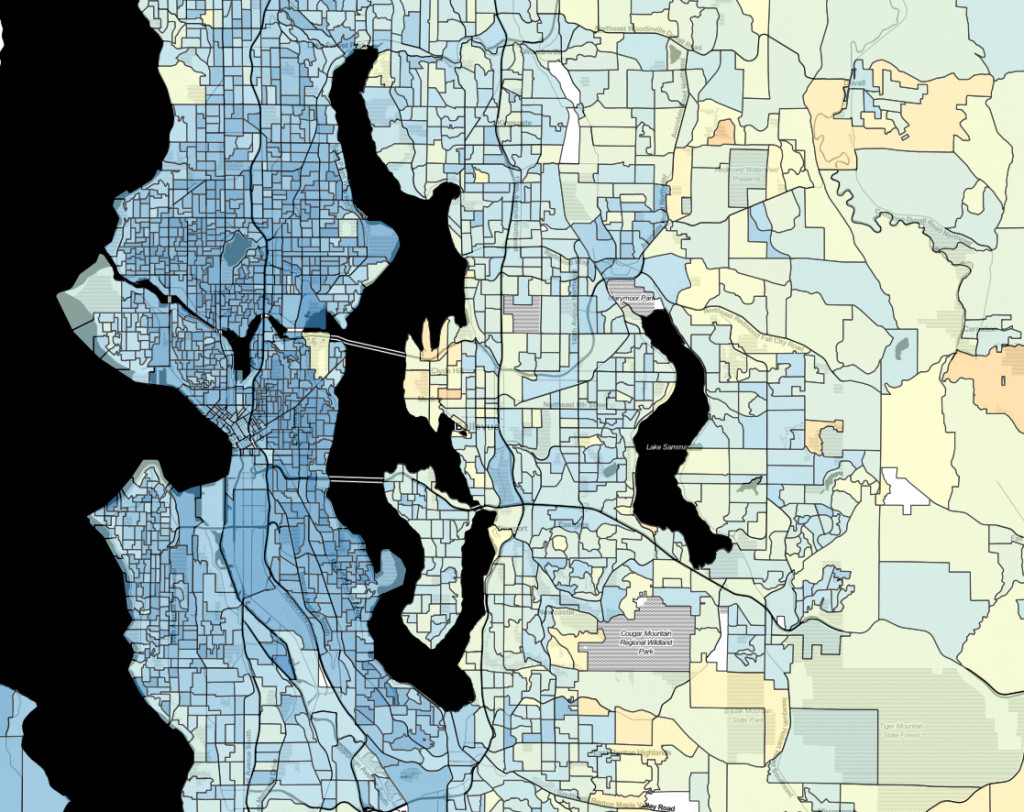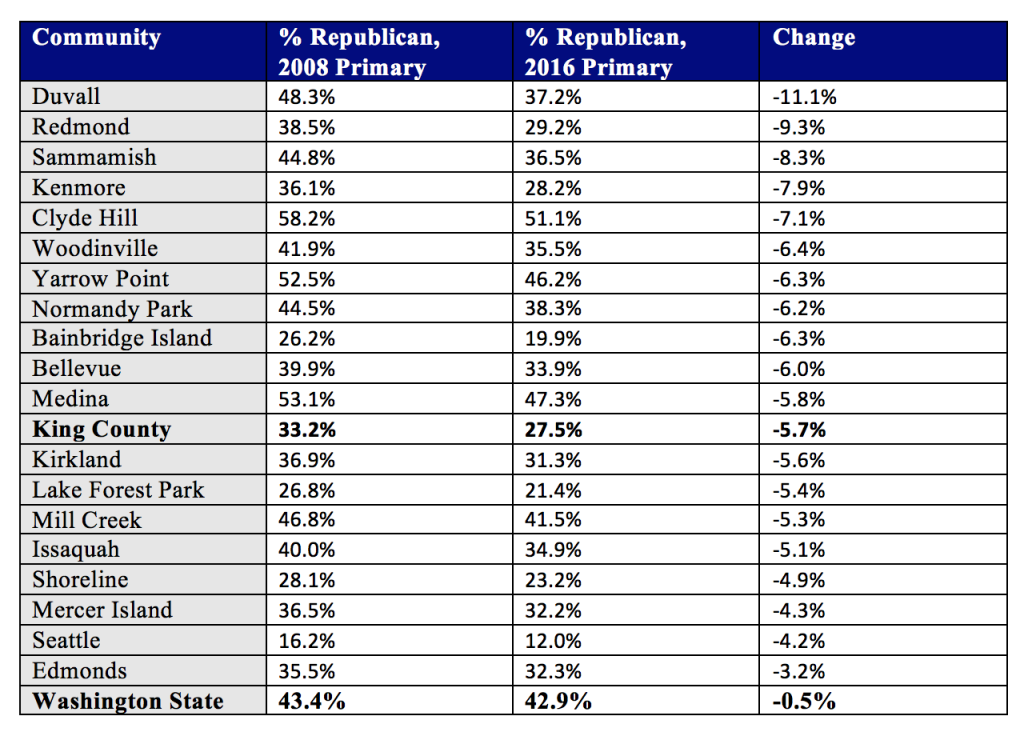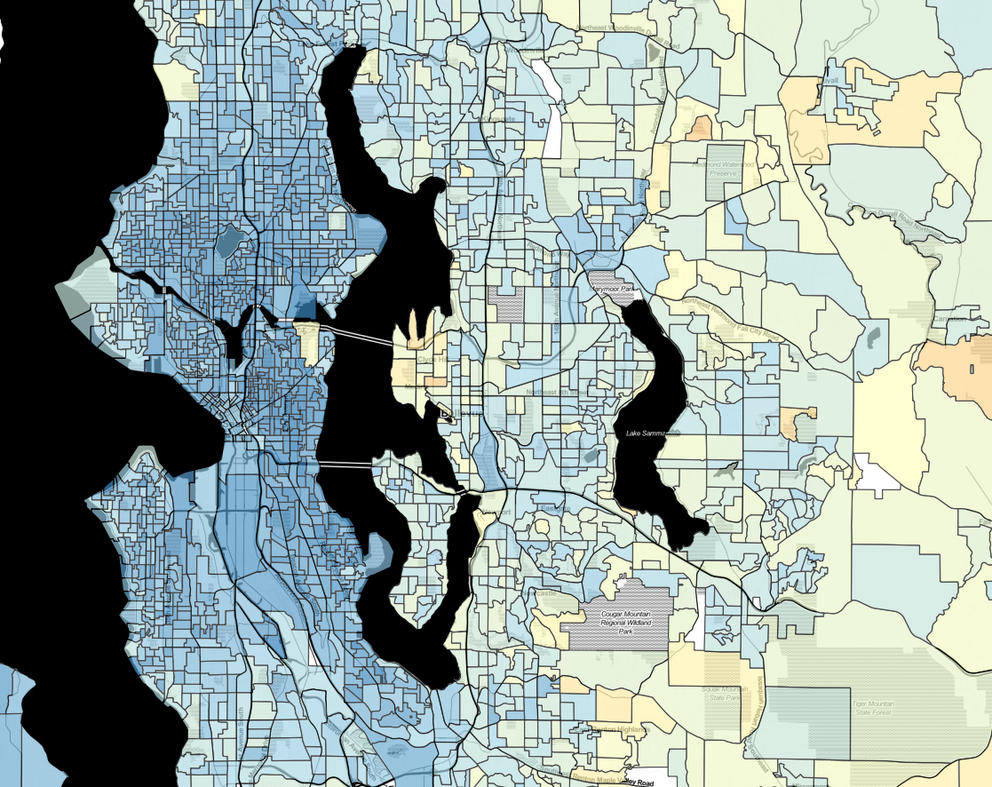Was last Tuesday one of the worst moments for local Republicans in recent history? When it comes to their party’s long-term chances in Washington state, it may well have been.
Despite denouncements from numerous local Republicans, Donald Trump was dominant in last Tuesday’s presidential primary. He received over three-quarters of the statewide vote, even breaking 70 percent in establishment-friendly King County. Mere weeks into his reign as presumptive nominee, he did what many pundits said he never could: consolidated the Republican base, and relegated his opposition to ineffectual protest-voting.
But a closer look at the numbers suggests that Trump is putting the Republican Party’s standing in the Puget Sound region, especially suburban areas, in jeopardy. Tuesday may not have been a sign that he was persuading educated, moderate Republican-leaners into his camp. It may have been a sign that he’s persuading them to stop voting Republican.
To explain, let’s start with a map: the precinct-by-precinct breakdown of Seattle-area ballots on Election Night. The darker the blue, the higher proportion of ballots that voted Democratic; the darker the red, the more Republican ballots.

This map is a lot bluer than usual. On Election Night, 73.2 percent of King County ballots were Democratic. That figure has retreated slightly to 72.5 percent after additional ballot counts, but nonetheless, it’s unprecedented. That’s higher than Barack Obama received for both his first run (70.0 percent) and re-election (68.7 percent). It’s also way more than the proportion of Democratic ballots in the presidential primary before that record-setting first win (66.8%).
Trump may have overwhelmingly won the Republican side, but he did so with a record-low share of suburbanites picking the GOP option.
Democratic ballots had huge advantages in Seattle (88.0 percent), Bellevue (66.2 percent), Kirkland (68.2 percent), Mercer Island (67.8 percent), and Redmond (70.8 percent). Democratic ballots even edged out Republican ballots in the Gold Coast – the ultra-wealthy communities of Medina, Hunts Point, Yarrow Point, and Clyde Hill, located between Mercer Island and Bellevue. Back in the 60s, these areas were Republican strongholds, Goldwater country.
Election nerds may note that these areas voted Democratic once before – back in Obama’s 2008 landslide. But even then, they didn’t vote Dem in the February 2008 primary. Indeed, many of Washington’s suburbs have seen big drop-offs in Republican voting between 2008’s primary and last week. These drop-offs appear strongly associated with income, but even more so with education levels.

This wasn’t what local Republicans were hoping for. Going into the primary, it was expected that many moderate, GOP-leaning voters might cast a protest vote for John Kasich. While some did – Kasich did well in the above cities, breaking 20 percent in several of them, another bad sign for Trump – it appears some of them didn’t. Instead, they voted Democratic.
This pattern wasn’t unique to the Seattle area. Educated suburbs around Spokane, Tacoma, Vancouver and even the ruby-red Tri-Cities all saw the GOP take a hit. This is despite the fact that the Republican primary was used to allocate all delegates this year, and only half of them in 2008.
Indeed, Trump-friendly areas did see an increase in Republican vote share. In the working-class areas where Trump excels – like Grays Harbor County, Kelso-Longview, and rural Eastern Washington – GOP voting leaped. Still, the bleeding in well-educated suburbs (and well-educated Seattle) was so bad that the statewide Republican vote share actually fell.
These results are especially impressive because these educated, wealthy suburbanites loved voting for Obama in 2008. The cities above delivered Obama some of his biggest margins versus Hillary Clinton. He was even more popular among suburban swing voters in the General Election, setting all-time records for Democratic performance on the Eastside. And yet, Trump’s 2016 toxicity with suburban voters may even outpace Obama’s 2008 strength.
It’s hard to find silver linings here for Republicans. This year’s primary was lower-turnout than 2008, but I found no signs that demotivated Republicans explain the GOP drop in the Seattle suburbs. If this were true, you would expect to see the biggest declines in turnout there; to the contrary, these were some of the few areas where turnout held up.
There are certainly many places in the country where Trump will expand the Republican base. But, unlike some states, Washington has more Redmonds and Mill Creeks than Aberdeens and Longviews. For local Republicans, battling in key suburban districts and on down ticket races, last week’s results shouldn’t be a comforting sign of party unity. In fact, they should be downright ominous.
Stray observations:
- Seattle got even more Democratic. If it’s possible for Republicans to become more endangered in Seattle, this year might do it. In 2008, Seattle was a record-low 16.2 percent Republican in the February primary. This year’s figure, 12.0 percent, is more than one-quarter lower. Fifteen years ago, only Seattle’s bluest areas were under 10 percent Republican. This year, suburban neighborhoods like Wedgwood and Meadowbrook have joined those ranks.
- …but Seattle didn’t feel the Bern. King County’s strong margin for Hillary Clinton wasn’t all about the ‘burbs. Early results have Clinton doing better in Seattle (58 percent) than countywide. Clinton mostly swept all but the city’s youngest neighborhoods and few areas with lots of working-class white (like Delridge). Sanders even lost Capitol Hill, although he did narrowly snag Fremont, Greenwood, and the U-District. Adjust your local stereotypes accordingly.
- These new tech workers aren’t Republicans. There’s been some question about the politics of the area’s new young, high-income workers. At least in terms of partisanship, here’s our answer: they’re very Downtown Redmond hit 80 percent Dem in the primary. An even better metric is the apartment-heavy precincts in Ballard, Interbay, and South Lake Union, which are dominated by these voters. Combined, these precincts voted Democratic by a staggering 12-to-1 margin (and they favored Sanders).
- Non-election beats actual caucus. Back in February, Washington’s Democratic caucus brought out about 230,000 Democrats. Not bad for a Saturday morning. But voters still seem more willing to participate in a non-binding vote than attend a caucus. It looks like about 3.5 times as many Democratic “votes” (800,000) were cast in the “primary.”
- There are still 160 days until the election. Sorry, everyone. Drink up!



